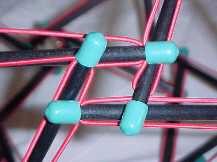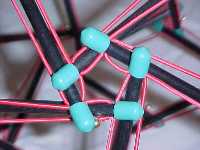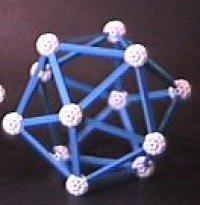The Geometry of Harmony
Geometry is the most fundamental subject in the universe, for it describes the relationships between all things. The application of geometry to life can help us to better understand life.
Tensegrity
This article will be looking at harmony and geometry, particularly, tensegrity, and it's relationship to life. Tensegrity is a word coined by R. Buckminster Fuller in his masterwork Synergetics. A tensegrity structure is one which is defined by tensional forces, not compression member forces. In a standard building, you start with posts and beams which absorb the forces placed on top of them. A post or a beam will fail if there is too much stress locally on one part of it. It is rigid and cannot flex or adapt holistically to forces placed locally on any one point of the structure. But a tensegrity structure balances the forces around and within it. It is dynamic and can respond to change, just as life can.
Bucky says that all structures in the Universe, from the solar system to the atom, are tensegrity structures.
We will see how tensegrity relates to harmony, and by looking at these structures, discover the true definition of harmony.
These are examples of tensegrity structures.
Picture 1 A basic tensegrity structure. (1)

Picture 2 A geodesic dome. The Geosphere at Disney World (2)

Picture 3 Showing tensegrity struts with attached tension wires and caps. Also showing more clearly how the struts are independently islanded within the structure. (3)

Picture 2 is a geodesic dome, the famous geosphere at Disney World in Florida. Picture 1 is an icosahedron, the base geometry from which Class I geodesic domes are constructed.
Picture 3 shows how each strut has a tension wire connected to it, and how the struts have notches in them to connect to other tension wires on other struts, and are capped at the ends. (These pictures are models only. A tensegrity strut could be manufactured differently, but the principles are the same as shown here).
Look at Picture 1 again. None of the struts ever touch each other. They are independently islanded so that if forces act upon it, the entire structure immediately finds balance. When a structure is built in this way, it can withstand tremendous forces upon it. If you push on one end of it, there will be an immediate, uniform and symmetrical response around the entire structure. It is dynamic and can flex inwardly and outwardly, always finding equilibrium within itself. In other words, it can easily adapt to change. (A conventionally built structure, with all of the ends connected to each other, is brittle and will collapse under stress at the localized point of pressure.)
3 strut tensegrity vertex (4)

4 strut tensegrity vertex (5)

5 strut tensegrity vertex (6)

You can see here that the ends of the struts in a tensegrity design do not come together. This picture doesn't show it very well, but the ends of the struts do not lay upon each other, they are held by the balanced tensional forces of the structure apart from one another. (See picture 1 and 3 at the beginning of the article.)
The wires are shorter than the struts, so that when a strut is inserted into the structure, the wires stretch a little, providing tension. The struts pull upon the stretched wires and the tension wires provide an inward force which the more rigid struts resist. All of the struts want to fly radially outward, but they are resisted by the tensional force which tries to push it together. The inward and outward forces generated by the structure is a synergetic combination of ALL of the struts and tension wires, so that, in a large structure with lots of struts, even if you removed a bunch of them the system would not fall apart. It would immediately re-balance internally all of the forces acting upon it. The tensegrity system is in perfect balance.
This is a brilliant innovation because if you work with tensegrity you can see that the structure internally generates all of the forces upon itself, and within it. It generates its own energy and dynamically balances it. It does not require energy from the outside. It is self-contained, independently energy generating and self-balancing. If you built one of these things out in space it would operate the same way as when subjected to a gravitational field. In fact if you study a tensegrity structure for a while you can see that it generates its own gravitational force, circumferentially, upon itself, and also generates an outward, anti-gravitational, force which balances the inward force.
If you play with one of these things you can feel the energy within it and can see immediately how it can come quickly to balance when subjected to outside forces. It's almost as if the thing were alive.
Tensegrity is the epitome of the holistic idea.
The brilliance of tensegrity comes from one simple, but powerful idea: each strut has attached to it a tension wire which is shorter in length than the length of the strut. The tension wire is forced to stretch a little when attached to another strut. This is the source of the energy generated within the structure: a tension, like a coiled spring, that creates potential energy that can be released.
Why am I spending so much time talking about this?
Because life itself is similar to tensegrity.
We look around on planet earth and see contrast and diversity everywhere, which provides tension. The contrast provides tension, because there is so much out there that we don't like. There are so many ideas, so many opinions, so many different activities going on that we wouldn't in a million years want to have anything to do with. The natural impulse is to say: "OK, lets get rid of all of this garbage. Lets create a world of harmony and peace so that all can be comfortable."
That's a great idea, except that it doesn't work!!
Like a tensegrity structure, it is the tension provided by life’s contrasting and diverse elements that gives life its dynamic quality.
It's the tension that provides the dynamic, self-balancing energy for the tensegrity structure, and its the contrast of opinion and action that provides the dynamism for life itself to exist, to be in balance, and to grow. Without tension, without contrast, there is weakness, brittleness, non-responsiveness to change, stagnation, and yes, if carried far enough, death.
Picture 4 A structure where all of the elements are touching at the vertices. (7)

This is a smaller version of Picture 1 (icosahedron). The struts are constrained to come together at every point. This structure will fall apart when subjected to stress, because the blue compression struts have nowhere to go and so will break at the point of pressure.
A harmonious, peaceful world is like a structure when it is made out of materials that all come together at the vertices (Picture 4).
It falls apart under stress, because there is no self-generated energy from within the structure. There is no holistic balance of forces. There is no room for change. This kind of structure can be beautiful, but it cannot adapt. It is fixed in position, and cannot change.
It cannot change because the individual pieces of which it is composed have no freedom to operate.
They are constrained to come together.
The tensegrity structure, remember, is composed of individual struts which never touch each other, yet all of these struts are connected by the tension wires and share the entire energy of the structure. In fact, each member is responsible for creating the energy of the whole. Without any one individual element, the structure could not exist in wholeness. Of course, it would still exist, but it would be less than complete. That is why in life every being is so important. Every individual is creating and balancing the energy of the whole. All individual members of the structure are intimately connected, yet have the freedom to go their own individual way. All of the elements of the structure are happy to see every other member doing their own thing, completely and fully allowing independent expression and action, while at the same time being connected to the whole.
Harmony is created by the tolerance of different ideas. Disharmony is created when individuals or groups contest for domination of the human idea space.
The allowance of independent expression is critical to the idea of harmony.
In order to have true harmony, there must be dynamic tension, there must be contrast, and there must be freedom of expression. And there must be allowance. Unconditional allowance is the same thing as unconditional love.
Each person must be allowed to go his or her own way, while still being part of the whole. This creates diversity of opinion and allows for maximum creativity.
“That is crazy,” you say. “Are we to tolerate psychopaths and murderers who go around destroying society?”
All I will say to this is that intolerance – particularly in a person’s formative years – creates the hatred and psychosis that results in adults becoming anti-social. A child who is loved is unlikely to demonstrate anti-social behavior as an adult.
A World of Peace and Harmony
When people think of a world of peace and harmony, they think of a world where all of the bad stuff has been eliminated. This concept, however, requires other people to constrain their actions in order to satisfy others who may not like those actions. A world where all ideas and activities have been whittled down to those which everyone can agree upon is stagnant. It is static, not dynamic. There is no diversity providing the tension which gives birth to new ideas, new desires, new ways of doing things. Like the brittle structure, it falls apart when buffeted from the outside, or from within. It has less integrity, it cannot respond to changing conditions.
This is the world of the dictator, the materialist, the control freak, and the collectivist, which manifests itself socially as rigid intolerance and hatred.
Tensegrity tells us that harmony is not everyone agreeing with each other. Harmony (and love) is allowing.
Conclusion
Like the tensegrity structure, each being must be allowed freedom while still being connected to the whole.
_____________________
Notes
(1), (3) Images from Design Science Toys web site at www.dstoys.com
(2) Picture from Chris Rywalt's Synergetics Photo Page at westnet.com/
~crywalt/photos/photos.html
(4), (5), (6) Images from Holistic Geometry, by Marvin Solit, Foundation for New Directions, at www.fnd.org/geo.htm
(7) Image from George W. Hart's awesome web site at www. georgehart.com